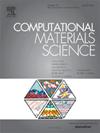Chemical removal and physical damage in the dry etching process of diamond: A case study of Ar and F etching through reactive molecular dynamics simulations
IF 3.3
3区 材料科学
Q2 MATERIALS SCIENCE, MULTIDISCIPLINARY
引用次数: 0
Abstract
Advancing diamond semiconductor applications requires a comprehensive understanding of the physical and chemical effects of the dry etching process. However, these effects remain elusive at the atomic level due to the complex interactions that occur during the etching process. By investigating the etching behaviors of Ar and F atoms on diamond slabs, this study aims to clarify the complex interplay of physical and chemical effects during the diamond etching process. Due to its extreme inertness, Ar atoms only interact physically with diamond slab. The bombardment of Ar atoms below 75 eV resulted solely in amorphization damage of the diamond surface, whereas bombardment above 75 eV induced both amorphization and sputtering. The F atoms with low incident energy mainly reacted with the surficial C atoms, causing chemical removal in the form of gaseous products. However, amorphization damage also appeared as the incident energy increased above 50 eV, suggesting that physical interaction also plays a key role in F etching at high energies. This study provides a detailed explanation of the physical and chemical effects of the diamond etching and provides invaluable guidance on the application of Ar and F etching.

金刚石干刻蚀过程中的化学去除和物理损伤:以反应分子动力学模拟的Ar和F刻蚀为例
推进金刚石半导体应用需要对干蚀刻工艺的物理和化学效应有全面的了解。然而,由于在蚀刻过程中发生的复杂相互作用,这些效应在原子水平上仍然难以捉摸。通过研究Ar和F原子在金刚石板上的蚀刻行为,本研究旨在阐明金刚石蚀刻过程中物理和化学效应的复杂相互作用。由于氩原子的惰性,它只与金刚石板发生物理作用。低于75 eV的Ar原子轰击只导致金刚石表面的非晶化损伤,而高于75 eV的轰击同时引起非晶化和溅射。低入射能量的F原子主要与表面C原子反应,以气态产物的形式进行化学去除。然而,当入射能量增加到50 eV以上时,也出现了非晶化损伤,这表明物理相互作用在高能F刻蚀中也起着关键作用。本研究详细解释了金刚石刻蚀的物理和化学效应,为Ar和F刻蚀的应用提供了宝贵的指导。
本文章由计算机程序翻译,如有差异,请以英文原文为准。
求助全文
约1分钟内获得全文
求助全文
来源期刊

Computational Materials Science
工程技术-材料科学:综合
CiteScore
6.50
自引率
6.10%
发文量
665
审稿时长
26 days
期刊介绍:
The goal of Computational Materials Science is to report on results that provide new or unique insights into, or significantly expand our understanding of, the properties of materials or phenomena associated with their design, synthesis, processing, characterization, and utilization. To be relevant to the journal, the results should be applied or applicable to specific material systems that are discussed within the submission.
 求助内容:
求助内容: 应助结果提醒方式:
应助结果提醒方式:


